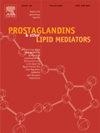Magnoflorine alleviates nonalcoholic fatty liver disease by modulating lipid metabolism, mitophagy and inflammation
IF 2.5
3区 生物学
Q3 BIOCHEMISTRY & MOLECULAR BIOLOGY
Prostaglandins & other lipid mediators
Pub Date : 2025-05-14
DOI:10.1016/j.prostaglandins.2025.106997
引用次数: 0
Abstract
Background
Nonalcoholic fatty liver disease (NAFLD) is a prevalent liver condition associated with metabolic syndrome, often aggravated by inflammation and mitochondrial dysfunction. This study aims to explore the therapeutic potential of magnoflorine, an alkaloid with known anti-inflammatory properties, in ameliorating NAFLD by modulating mitochondrial autophagy and inhibiting the NLRP3 inflammasome.
Methods
Male C57BL/6 J mice were fed a high-fat diet (HFD) for 16 weeks to induce NAFLD. Magnoflorine (5 and 10 mg/kg) was administered by gavage daily for 16 weeks. Liver and serum samples were analyzed for lipid profiles, inflammation markers, and autophagy-related proteins, and liver histology was examined to assess changes.
Results
Magnoflorine treatment improved dyslipidemia in NAFLD mice, shown by decreased serum triglycerides, total cholesterol, and LDL-C, and increased HDL-C. Histological analysis showed reduced hepatic steatosis and inflammation, with less lipid droplet accumulation and hepatocyte ballooning. Western blot results indicated upregulation of Parkin and PINK1, and downregulation of NLRP3, ASC, and caspase-1, with lower serum IL-1β levels, reflecting reduced inflammation.
Conclusions
Magnoflorine offers a promising approach for mitigating NAFLD progression through modulating mitochondrial autophagy and inhibiting inflammation.
木兰花碱通过调节脂质代谢、线粒体自噬和炎症减轻非酒精性脂肪性肝病。
背景:非酒精性脂肪性肝病(NAFLD)是一种与代谢综合征相关的常见肝病,常因炎症和线粒体功能障碍而加重。本研究旨在探索木兰花碱(一种已知具有抗炎特性的生物碱)通过调节线粒体自噬和抑制NLRP3炎症小体来改善NAFLD的治疗潜力。方法:雄性C57BL/6J小鼠高脂饲料(HFD) 16周诱导NAFLD。木兰花碱(5和10mg/kg)每日灌胃,连续16周。分析肝脏和血清样本的脂质谱、炎症标志物和自噬相关蛋白,并检查肝脏组织学以评估变化。结果:magnnoflorine治疗改善了NAFLD小鼠的血脂异常,表现为血清甘油三酯、总胆固醇和LDL-C降低,HDL-C升高。组织学分析显示肝脏脂肪变性和炎症减轻,脂滴积聚和肝细胞球囊变少。Western blot结果显示,Parkin和PINK1上调,NLRP3、ASC和caspase-1下调,血清IL-1β水平降低,反映炎症减轻。结论:木兰花碱通过调节线粒体自噬和抑制炎症,为缓解NAFLD进展提供了有希望的途径。
本文章由计算机程序翻译,如有差异,请以英文原文为准。
求助全文
约1分钟内获得全文
求助全文
来源期刊

Prostaglandins & other lipid mediators
生物-生化与分子生物学
CiteScore
5.80
自引率
3.40%
发文量
49
审稿时长
2 months
期刊介绍:
Prostaglandins & Other Lipid Mediators is the original and foremost journal dealing with prostaglandins and related lipid mediator substances. It includes basic and clinical studies related to the pharmacology, physiology, pathology and biochemistry of lipid mediators.
Prostaglandins & Other Lipid Mediators invites reports of original research, mini-reviews, reviews, and methods articles in the basic and clinical aspects of all areas of lipid mediator research: cell biology, developmental biology, genetics, molecular biology, chemistry, biochemistry, physiology, pharmacology, endocrinology, biology, the medical sciences, and epidemiology.
Prostaglandins & Other Lipid Mediators also accepts proposals for special issue topics. The Editors will make every effort to advise authors of the decision on the submitted manuscript within 3-4 weeks of receipt.
 求助内容:
求助内容: 应助结果提醒方式:
应助结果提醒方式:


